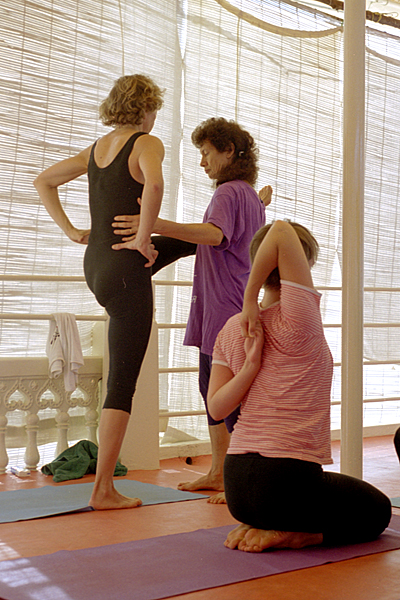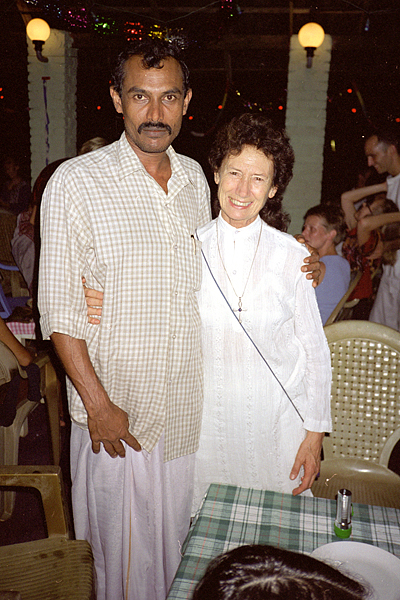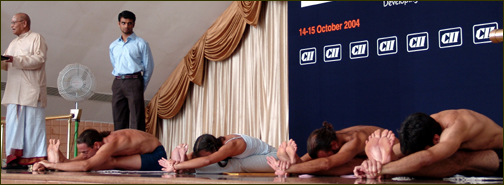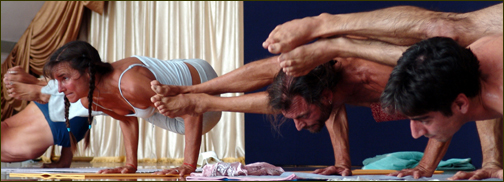alan little’s weblog archive for november 2004
gwendoline hunt r.i.p.
24th November 2004 permanent link
Yoga teacher Gwendoline Hunt is dead, drowned last week on a coastal hike in New Zealand.
I met and studied with Gwendoline three times, and she made a big impression on me. She was practicing advanced ashtanga yoga in her early 70s, which is no mean achievement physically, and puts any regrets I might have about not having started yoga until my late 30s into perspective. She was also one of a handful of people I’ve met in the course of my yoga studies who I regard as authentic geniuses in their understanding of the human body and how it works. She could show you, with the lightest possible touch in exactly the right place and direction, how to get far beyond what you thought were your physical limits.
Those are outward achievements, washed away by the Pacific Ocean now, and they don’t really matter any more. What remains and still matters is the kind, joyful, open-spirited person she was. The sort of person who, just by being who and how she was, could convince a struggling middle-aged yoga beginner that yoga must be worth persevering with if this is the sort of person it attracts and/or produces.
If there is reincarnation, Gwendoline, have a great time in your next life.
There is a memorial page for Gwendoline at ashtanga.com


Gwendoline teaching, and with her good friend Vijay (who is another of the handful of true bodywork geniuses I have met, and on whom more another time)
related entries: Yoga
selling fear
23rd November 2004 permanent link
Interesting documentary on German TV last night – interesting not only for what it was about but also for the way it was pitched, which was almost diametrically opposite to what it was actually saying.
It was about Acid Fog in the Bayerischen Wald (Bavarian Forest) National Park. The Bavarian Forest is on the German-Czech border and is one of the world’s most severely acid-damaged forests. According to the researcher in the documentary, more of the damage is actually caused by fog than by acid rain. Fog forms and moves close to the ground, and so picks up much higher concentrations of acid and other pollutants than rainclouds. In the Bavarian Forest fog from the east, that has passed over the Czech, Polish and former East German industrial regions, is particularly noxious.
So far, so alarming.
The next bit is mentioned almost as an aside. Admittedly pollutant levels in fog now, especially fog from the east, are a tenth of what they were fifteen years ago, and the forest is recovering. Hurrah. Excellent news. But let’s not get complacent: pollutant levels in the soil are still high, and the pollutants haven’t worked their way down into the groundwater yet. It won’t be good when they do.
What I think we have here: mostly excellent news. There was very serious environmental damage, mainly caused by the way communists ran their heavy industry. The cause of the problem has largely been solved, although its aftereffects haven’t fully worked their way through the system yet and could still be nasty. But this is me reading between the lines. The tone of the documentary was shock and gloom: acid fog even scarier than acid rain! Acid Fog Will Eat The World!
Climate researchers and documentary producers don’t pitch for funds by saying “oh yeah, it’s largely a solved problem, we just need to keep an eye on the aftereffects”. I respect the work these people are doing and I’m glad somebody is doing it. It may be that they have to believe the world is ending in order to keep themselves motivated to do it. But it isn’t. They’re literally selling to our lowest instincts: the reptile hindbrain reacts to threat first and opportunity second. This is what TV journalists do for a living:
If something seems scary (suggested by tone of voice, excitement, stridency and soundtrack) our unblinking lizard brain pays close attention, while ignoring the more relevant news: green grass, skies of blue; people all around us, saying how d'ya do.
The Bavarian Forest is just a couple of hours’ drive from where I live, and (even in a state of recovery from acid poisoning) it’s supposed to be very beautiful. I must go there instead of to the Alps one weekend.
gamma synchrony and yoga
18th November 2004 permanent link
One interesting point in the study of buddhist meditation I mentioned previously that may be very yoga-relevant: they talk about having to filter out signals on particular gamma band frequencies that are known to come from muscular activities, and that might otherwise interfere with measuring gamma band activity generated within the mind.
Now, one purpose of all the physical stuff in yoga is to serve as a focus point for “single-pointed meditation” – a different form of meditation, in buddhist terms, from the one being studied here.
But it’s also about training the body to be able to sit comfortably for long periods to meditate with minimal muscular activity. There’s a reason why seated Buddha figures are usually shown sitting in lotus position. Lotus, once you can do it comfortably, is the most stable, supported seated position there is. But for most people, especially most westerners who grow up never squatting or sitting on the floor, getting enough mobility in the hips, and enough strength in the core muscles of the abdomen, to be able to sit in it without strain in the hips, knees and lower back is a major undertaking. That discomfort in itself is a major distraction from meditation – it’s even worse if the muscular activity that accompanies it – tension, fidgeting – is generating interference in the very brainwave frequencies you’re interested in.
A yoga teacher I’ve studied with a couple of times, who also practices zen meditation, said he once asked his zen teacher how people who haven’t practiced yoga manage to get through long seated meditation sessions without excruciating pain. The zen teacher says the ability does come, eventually, but more slowly than with yoga practice.
related entries: Yoga
gamma synchrony
18th November 2004 permanent link
Long-term meditators self-induce high-amplitude gamma synchrony
Experienced Tibetan Buddhist meditators practicing “unconditional loving-kindness meditation” generate the highest levels of gamma synchrony that have ever been measured in trials of normally-functioning brains, and still have significantly higher base levels before and after meditation than a control group of students with rudimentary meditation training. General discussion; pdf of the technical paper.
So what is “gamma band synchrony” anyway? Google tells us that it is strongly present in musicians listening to music (really listening to music … is actually quite an advanced form of meditation)
It “may reflect one way in which the brain ‘integrates’ activity from the plethora of its ongoing parallel processes”. It “has been related both to gestalt perception and to cognitive functions such as attention, learning, and memory”.
Patients with schizophrenia had significantly reduced gamma phase synchrony.
There is one clear problem with the study, that the authors do partly address: the meditators are mostly middle-aged Tibetan monks; the control group are American college students. So, are the differences they are measuring actually brought about by meditation practice and not by age, by cultural differences between America and Tibet, or by people who already have these characteristics pre-selecting themselves for monastic life? The authors do address these questions, and say no: the difference they measured correlates more strongly with length of meditation training than with age. Clearly more research needed in this area though: it would be reassuring to see a study that compared middle-aged Tibetan monks to a control group of middle-aged Tibetan non-monks, and/or one that followed novice monks at various stages in their training.
I find studies like these fascinating. From a yoga student point of view, it’s clear that yogis and buddhist meditators for thousands of years have been on to something real that western science is just beginning to scratch the surface of understanding. And from a software point of view(*), we [“we” = neuroscientists] are trying to reverse engineer a system where the software is rewiring the hardware it runs on at runtime, with only the crudest ways of measuring the outward state of the system. This is something like, I don’t know … trying to understand how Photoshop works by measuring the temperature of the cpu and the amount of hard disk activity, guided by a vague second hand description of the picture on the screen. (Or something. Clearly this analogy needs more work). Only the system you’re trying to study is orders of magnitude more complex than (even) Photoshop. It’s amazing that neuroscientists manage to get anywhere at all.
Is a study of Buddhist meditators necessarily relevant to yoga? I think so. I don’t claim to know much about the similarities and differences between Hindu and Buddhist theology & philosophy, but what I’ve read here and elsewhere about Tibetan meditation seems similar enough to what I read in Patanjali’s Yoga Sutras that I’m fairly confident that the mental states aimed at are similar, even if the techniques used look outwardly very different.
Link from the psychology and neuroscience of religion thread in the ezboard ashtanga yoga discussion group.
(*) My working assumption is that the mind is, at least in principle, explainable in purely material terms as software processes running on hardware – no spirit required. It may be that the complexity of the human mind is beyond the capacity of the human mind to grasp; it may be that quantum uncertainty makes it impossible in principle to fully understand it. But ultimately it’s still all just quanta and the laws of physics.
notes on nancy, part three
15th November 2004 permanent link
Yogablogging: various notes about, and/or random thoughts inspired by, the yoga course I did last month with Nancy Gilgoff. Part Two.
Some of this stuff enters into the realms of yoga controversy, so I want to be clear where I’m paraphrasing (my recollection of) what Nancy said, and where I’m expressing my own opinions. [I will put bits where I’m editorialising, that may not reflect anything Nancy said or believes, in square brackets]
Nancy says there are a lot of people hurting themselves in yoga these days – lower back, neck, knee and hamstring injuries – and there weren’t twenty years ago.
She attributes this to the creeping influence of Iyengar yoga notions of “correct” posture and alignment in a different form of yoga practice where they don’t belong.

Some advanced yoga practitioners demonstrate forward bends with impressively straight backs.


Some even more advanced yoga practitioners demonstrate impressive indifference to whether their back are straight or not in forward bends: Pattabhi Jois, photographed about fifty years ago, and his teacher Krishnamacharya – arguably the most influential yoga teacher of the last century. (Apologies for the lousy quality of these pictures, which I got by photographing pages in books)
This contrasts with the approach normally taught by Iyengar yoga teachers who emphasise folding from the hips and keeping the back as straight as possible. Here’s one of the things I respect very highly about Nancy. She explains what she believes and why she believes it, but then she also talks with obviously sincere respect about people who have quite different opinions. She mentions another senior and highly respected asthanga teacher (Graeme Northfield I think) who insists on the straight back approach because, she says, it’s what worked for him. Which is why she doesn’t believe in preconceptions about “correct” posture and alignment: “I can’t imagine there’s any one position that’s right for everybody”, and, “if what you’re doing [e.g. straight back] is causing you pain, then do the opposite [e.g. round back]”. [I’m quite sure this is true. Problem: most yoga students don’t have the confidence or experience to know if the position they are trying to get into is right for them. Bigger problem: many yoga teachers probably don’t either]
Note that Nancy absolutely isn’t against Iyengar yoga as a form of practice in it’s own right and speaks with very high respect about Iyengar teachers she has studied with – it’s the mishmash of styles and confused mixing of ideas about how to do things that she’s against.
[My thoughts on this for what they’re worth (note that Nancy has been practicing four times as long as I have and has seen a lot more than four times as many yoga students): I don’t doubt that what Nancy says she sees is true. But here are also an awful lot more people practicing yoga at some level now than there were twenty years ago, and more people hurting themselves is probably inevitable when that happens. Twenty years ago, only a few dedicated people were practicing ashtanga yoga. Now, lots of people are doing it and many of them are doing it on a casual, a couple of classes a week basis which is far more dangerous than dedicated daily practice – more thoughts on this to follow. The average level of teachers’ experience is lower too. I mean no disrespect to the many dedicated and well-intentioned people who are teaching ashtanga yoga these days. But twenty years ago, the only people teaching it were Pattabhi Jois, a couple of other very experienced Indian teachers, and a handful of Pattabhi Jois’s most senior western students who had all spent a lot of time studying with Pattabhi Jois in small groups with very hands-on teaching. Even in Mysore, the teaching just isn’t like that any more – there are many more students, and Pattabhi Jois is older. Less experienced teachers, (again, no matter how dedicated and well-intentioned nearly all of them undoubtedly are) inevitably means more mistakes in teaching, and more injured students.]
More thoughts on the subject of “alignment” and whether it matters from a yoga message board posting I read a couple of years ago (quoted at length because yahoo, these days, requires you to be registered to even read message boards)
… to suggest that “alignment” is of utmost importance and lack of this “alignment” is dangerous, is in itself an uninformed statement. All this hang up on starting a pose with a particular perception of “alignment” is from the BKS Iyengar newfangled method. This eye towards “alignment” is also increased by an attachment and false application of classical form (a western art, dance contrivance) laid onto the yoga system. “Alignment” in an asana develops over time with daily practice. It arises out of proper breath and gaze with mula and uddiyana bandhas. If the student or teacher is looking to create a renaissance inspired form of beauty in order to experience or begin the pose, then he or she is not practicing yoga but posing (ooh pretty).
Many long time ashtanga practitioners develop a graceful quality and line in their practice …. Many long time practitioners do not develop this quality yet have extraodinary, advanced practices with deep insight and experience of the practice as well as of yoga’s many facets. Should we judge a practice by this usually false graceful packaging? No way. Because geting hung up on “alignment” and slow, balletic movements are the biggest pitfalls and side tracks of an ashtanga practice. Focus on this crap and you'll never know what ashtanga practice is.
I am not engaging in some kind of ashtanga-versus-Iyengar sectarian Yoga War here. I have nothing against Iyengar yoga as such(*) – except where its ideas about how to do things intrude where they don’t belong, or when some of its practitioners falsely claim that theirs is the only safe and “correct” way to do things. I don’t like ashtangis who do that either.
(*) In fact, I have so little against Iyengar yoga that, this winter when my ashtanga teacher is in Mysore, I plan to go to classes with a friend of mine who teaches it. Not with any intention of switching, just to see what I might be able to learn from a slightly different yoga perspective.
Notes from the previous course I did with Nancy.
related entries: Yoga
yoga pics
10th November 2004 permanent link

These excellent pictures of a yoga demonstration in Mysore by some of Pattabhi Jois’s advanced students go some way towards remedying the lack of decent yoga asana photos on the web.
UPDATE: Brian Micklethwait say “I know I shouldn’t mock, but some of these pictures cry out to be the basis of a caption competition”. Don’t worry Brian, the greatest yogi is the one who enjoys his or her yoga practice the most. Brian is also impressed by the spectacular modern building in the photos, which I think is new since I was in Mysore three years ago, and correctly observes there is a lot more in India these days than “dust, poverty and big white cows”. Although it still has plenty of those too.
related entries: Yoga
website under construction
10th November 2004 permanent link
No updates lately because I’ve been playing with my weblog software (and still am, so bear with me if things look a bit broken/wierd from time to time). When I first started the blog, I went for a quick’n’dirty build-all-the-pages-every-time approach – which was fine to get something up as fast as possible, and wasn’t a problem when I hadn’t written nearly three hundred entries totalling over a megabyte of text. (Jeez. My PhD thesis was a megabyte Word file; it was much harder work and took a lot longer than a year and half to write). Lately, though, it’s been taking about twenty-thirty seconds to do a build. Twenty-thirty seconds every other day on average doesn’t sound like much; but I do a lot of builds while I’m editing too – I can’t proofread in an XML editor – and it was getting to be a pain.
The new version only builds pages that are affected by changed entries, and for the last week’s worth of entries takes seven seconds. Still too slow. Coming soon: Alan learns to use python’s built-in profiler.
So I’ve been using my blogging time for programming instead of writing entries for the last week or so. For some of that time I didn’t have a working version of the software at all without digging one off a backup disk. Why not? Surely I keep my development code and my live code separate? Not always, for something like this. I have wall to wall backups, and I know if I start messing with my live code, and break it, then I’ll be motivated to press on and fix it. Whereas if a development version doesn’t work, and I don’t have a lot of time available to fix it, I might just drop the whole idea for a few weeks. (No, this is not the way I behave on real projects for clients. It’s just how I choose to spend some of my free time)
In the interests of scientific performance tuning I wanted to change as many uncontrolled variables as possible all at once, so I also switched XML libraries. I had been using the fairly basic, not particularly prorgammer-friendly and not particularly fast ones that come with python. They were adequate for my rudimentary needs but I wanted to try out something a bit more modern and shiny.
Did some playing with libxml2 and quite liked it. Some people find libxml2 a bit too low-level, C-like and unpythonic; I didn’t have a problem with that, and would definitely consider using it for performance-critical production projects. But for doing something in limited time on a hobby project it still seemed like a better idea to look for something a bit higher level. From the reading I did, Fred Lundh’s elementtree looked like the one to try first. It works – installed first time, pretty simple and intuitive to use (although the little utility library I had built around python's minidom was too).
I might still take another look at libxml2 if I decide to do something about seven seconds still being an unsatisfactory build time for my blog – assuming I arrive at some understanding of the python profiler output and assuming XML parsing then turns out to be the actual problem, which it might not be. I didn’t do any benchmarking of my own, but people who have say elementtree is much faster than the standard python xml tools.
related entries: Programming
an apology
5th November 2004 permanent link
Another lesson for me about blogging and ahimsa.
A few weeks ago when I wrote about the Russian music download service allofmp3, I mentioned that museekster had a good review but it was in a “ridiculously tiny illegible font, they should sack their designer”. It is only in a ridiculously tiny illegible font in Safari, it is just fine in all other major browsers.
I apologise unreservedly to Hans Handgraaf, museekster’s designer, who sent me a very polite and friendly email and is clearly a nicer guy than I was being when I wrote that.
german bureaucracy
5th November 2004 permanent link
This morning Maria & I visited the Office For Telling People What Paperwork They Need In Order To Get Married In Germany. The lady there was polite, efficient and helpful, as Munich officials generally are in my experience. But. There are two things you can do about a process that is very complex and user-unfriendly. One is to radically simplify the process. The other is to set up an Office For Helping People To Do It, employing more officials. Only one of these solutions is ever likely to occur to the Official Mind. The German Official Mind is not unique in this.
If German bureaucracy turned out to be too horrendous, we had contemplated the possibility of just going to Las Vegas. But getting into the States these days is probably just as bad.
(In related news, implied but not yet actually mentioned: Maria has agreed to marry me.)
games women play
2nd November 2004 permanent link
Devious Things Women Do, Number 487: asking if you would like to come and have a look at what Christina Aguilera is wearing on TV. Damn right you would. Only gradually does it dawn on you that you were supposed to disapprove.
damning with damning
2nd November 2004 permanent link
Greg Sandow sometimes complains that the world of classical music performance and criticism is too closed and cosy; critics don’t criticise. You can never believe you’re hearing somebody’s honest opinion of something; you don’t get to enjoy panning performances as a bloodsport.
Honest opinions and criticism-as-bloodsport abound on the internet, of course.
They haven’t completely died out on Bavarian State Radio either. I was listening to Bayern 4 Klassik’s views on the Bavarian State Opera’s current production of The Magic Flute on my way to work this morning. “It’s a revival of a 25 year old production, but it feels a hundred years old … this is opera for schoolchildren: it may be ok if you’re seeing it for the first time, but it has nothing to offer the serious opera fan”.
So that’s one thing I won’t be needing a babysitter for.
related entries: Music
all text and images © 2003–2008